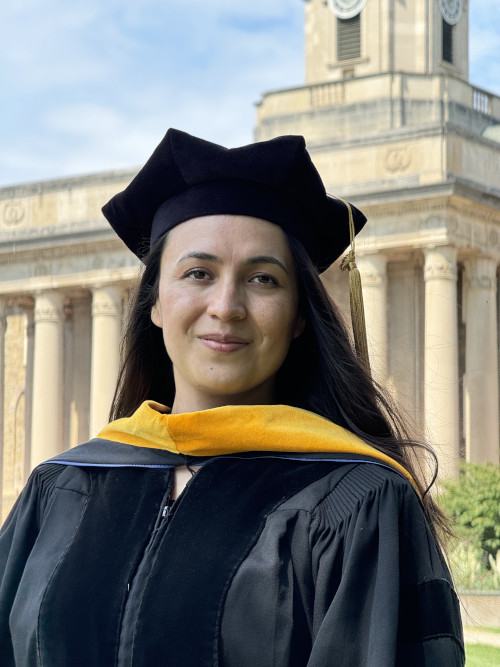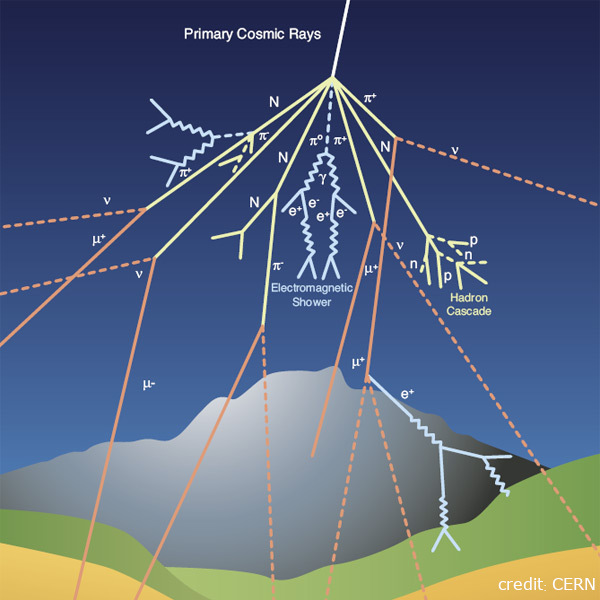
Cosmic Rays
Cosmic Rays are elementary particles and nuclei, detected on or near the Earth, that originate in energetic processes in the universe. Physicists work to characterize the cosmic ray spectrum: the abundance of different types of particles and their energies. Observations of the primary particles are made in space (e.g., the Alpha Magnetic Spectrometer, AMS, on the International Space Station) and with high-altitude balloons (e.g., the High Energy Light Isotope eXperiment, HELIX). When cosmic rays interact with the Earth's atmosphere, they generate showers of other particles, called secondary cosmic rays, that are detected by instruments on the ground (e.g., the Pierre Auger surface water tanks and fluorescence detectors), and under the ground (e.g., the AMIGA, Auger Muons and Infill for the Ground Array extension for Pierre Auger). Cosmic ray data is used to constrain models for sources that can produce high-energy particles, either extremely energetic astrophysical environments like those around Active Galactic Nuclei (AGN) or extreme events like gamma ray bursts (GRBs).
IGC members who study Cosmic Rays
| Name | Role | Affiliation | Phone | Office Address | Affiliated Center(s) | Research Topics(s) | ||
|---|---|---|---|---|---|---|---|---|
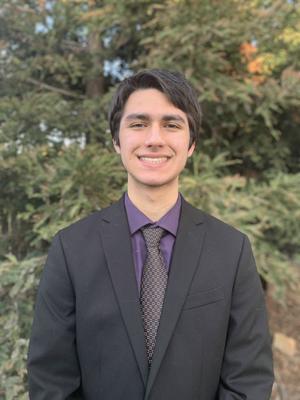 | Julien Alfaro | Graduate Student | Physics | jpa5771@psu.edu | +1 814 865 7533 | 204 Osmond Laboratory | IGC, CMA | Multimessenger Astrophysics, Cosmic Rays, Neutrinos |
 | Heather Allen | Graduate Student | Physics | heather.allen@psu.edu | --- | 204 Osmond Laboratory | CMA, IGC | Multimessenger Astrophysics, Cosmic Rays |
 | Tyler Anderson | Faculty | Physics | tba109@psu.edu | +1 814 865 2013 | 212A Osmond Laboratory | CMA | Cosmic Rays, Dark Matter, Neutrinos, Multimessenger Astrophysics |
 | Mukul Bhattacharya | Postdoc | Astronomy, Physics | mmb5946@psu.edu | -- | 320A Osmond Laboratory | CMA | Multimessenger Astrophysics, Gravitational Waves, Neutrinos, Cosmic Rays |
 | Carlos Blanco | Faculty | Physics, ICDS | carlosblanco@psu.edu | +1 814 865 7533 | 303K Osmond Laboratory | CFT, CTOC, CMA, IGC | Dark Matter, Neutrinos, Multimessenger Astrophysics, Cosmic Rays |
 | Yu Chen | Graduate Student | Physics | yuc357@psu.edu | -- | 205 Osmond Laboratory | CMA | Cosmic Rays |
 | Stephane Coutu | Faculty | Physics, Astronomy | sxc56@psu.edu | +1 814 865 2015 | 303H Osmond Laboratory | CMA | Cosmic Rays, Multimessenger Astrophysics |
 | Abhishek Das | Graduate Student | ICDS, Physics, Astronomy | ajd6518@psu.edu | -- | 321E Thomas Building | IGC, CMA | Cosmic Rays, Black Holes, Neutrinos, Gravitational Waves, Multimessenger Astrophysics, Dark Matter, Quasars |
 | Abe Falcone | Faculty | Astronomy | adf15@psu.edu | +1 814 863 5364 | 516 Davey Laboratory | CMA | Multimessenger Astrophysics, Cosmic Rays, Dynamic Universe, Quasars |
 | Eduardo Gutiérrez | Postdoc | Physics | exg5366@psu.edu | +1 814 863 9605 | 301B Whitmore Laboratory | IGC | Black Holes, Multimessenger Astrophysics, Neutrinos, Gravitational Waves, Cosmic Rays |
 | Yu Jiang | Faculty | Physics | yuj119@psu.edu | +1 814 863 0871 | -- Whitmore Laboratory | CMA | Cosmic Rays, Multimessenger Astrophysics |
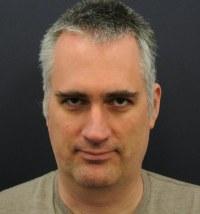 | Samuel Adam Isaac Mognet | Faculty | Physics | sam378@psu.edu | +1 814 865 6107 | 206E Osmond Laboratory | CMA | Dark Matter, Cosmic Rays |
 | Kohta Murase | Faculty | Physics, Astronomy | kum26@psu.edu | +1 814 863 9594 | 321B Osmond Laboratory | CMA | Cosmic Rays, Neutrinos, Multimessenger Astrophysics, Gravitational Waves, Dark Matter |
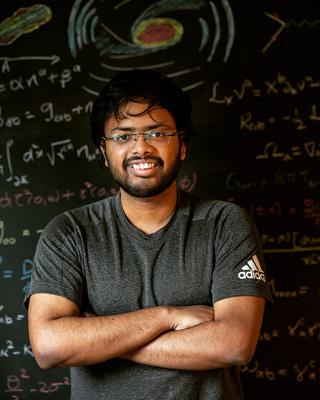 | Surendra Padamata | Graduate Student | Physics | ssp5361@psu.edu | -- | 322 Osmond Laboratory | CMA | Multimessenger Astrophysics, Black Holes, Cosmic Rays, Gravitational Waves, Neutrinos |
 | Kara Whitaker | Graduate Student | Physics | kbw5490@psu.edu | -- | 114 Osmond Laboratory | IGC | Cosmic Rays, Multimessenger Astrophysics |
 | Stephanie Wissel | Faculty | Astronomy, Physics | wissel@psu.edu | +1 814 863 9598 | 303B Osmond Laboratory | CTOC, CFT, CMA | Multimessenger Astrophysics, Cosmic Rays, Neutrinos |
 | Seonghyeon Yu | Graduate Student | Physics | sjy5345@psu.edu | --- | 204 Osmond Laboratory | CMA | Cosmic Rays |
 | Chengchao Yuan | Graduate Student | Physics | cxy52@psu.edu | +1 814 865 0153 | -- NONE | CMA | Neutrinos, Multimessenger Astrophysics, Cosmic Rays |
 | Andrew Zeolla | Graduate Student | Physics | avz5228@psu.edu | 7138709006 | 204 Osmond Laboratory | CMA | Multimessenger Astrophysics, Neutrinos, Cosmic Rays |
News about Cosmic Rays

New TIGER approved for deployment to the International Space Station
2022-09-26
A team of physicists that includes researchers at Penn State is developing a new experiment envisioned for the International Space Station (ISS) as part of NASA’s Astrophysics Pioneers Program. The new experiment, the Trans-Iron Galactic Element Recorder for the International Space Station (TIGERISS), will be designed to measure the abundances of ultra-heavy galactic cosmic rays—high-energy particles that have been rapidly accelerated from a star’s violent collapse, called a supernova, or other cosmic events such as the merger of two neutron stars. By measuring the quantity of each atomic element in cosmic rays, scientists gain information about where they could have originated.
TIGERISS is an evolution of the TIGER and SuperTIGER balloon-borne instruments, developed by scientists at Washington University, NASA Goddard, Caltech and others over the past three decades, with the Penn State contingent invited to participate in the next phase of the science program. “We are excited to join old friends from the cosmic-ray ballooning community in investigating the rare but fascinating ultra-heavy cosmic rays,” said Stephane Coutu, professor of physics and of astronomy and astrophysics and the Penn State lead investigator for the TIGERISS program. “The origin of the heavy elements of the periodic table, such as the gold you might wear around your neck or finger, ultimately links back to intriguing, violent and exotic astrophysical phenomena.”
Other Penn State team members include physics research professors Samuel Isaac Mognet and Tyler Anderson. Together the Penn State team has decades of experience successfully developing detector elements for space-rated instruments flown on high-altitude balloons or to the ISS where TIGERISS will be deployed in a few years.
Additional links:

NASA selects STAR-X for $3M mission concept study
2022-08-30
STAR-X, the Survey and Time-domain Astrophysical Research Explorer, a proposed NASA Medium-Class Explorer (MIDEX) mission that includes Penn State astronomer Niel Brandt, has been selected by the NASA Explorers Program for further study. STAR-X is one of two proposed MIDEX missions that will receive $3 million for a nine-month detailed study of mission requirements. At the end of this period, one of the proposed missions will be selected for a target launch date in 2027-2028 and be eligible for up to $300 million in additional funding.
Comprised of an X-ray telescope, an ultraviolet (UV) telescope, and a responsive spacecraft, STAR-X is designed to conduct time-domain surveys, which study how astronomical objects change with time, and to respond rapidly to transient cosmic events discovered by other observatories such as LIGO, Rubin LSST, the Roman Space Telescope, and the Square Kilometer Array. The mission is led by Principal Investigator William Zhang at NASA’s Goddard Space Flight Center (GSFC) in Greenbelt, Maryland. Penn State’s Brandt, who is the Verne M. Willaman Professor of Astronomy and Astrophysics and Professor of Physics, is involved in planning the STAR-X cosmic X-ray surveys, active galaxy studies, and fast X-ray transient studies.
“I can’t wait to use STAR-X to investigate the first supermassive black holes and understand mysterious, explosive X-ray transient sources,” said Brandt. “STAR-X will also provide the essential X-ray and UV follow-up capabilities for remarkable cosmic objects discovered by the Rubin LSST in optical light.”
The STAR-X spacecraft would be able to turn rapidly to point a sensitive wide-field X-ray telescope and a UV telescope at transient cosmic sources, such as supernova explosions and feeding supermassive black holes. Deep X-ray surveys would map black holes and hot gas trapped in distant clusters of galaxies; combined with infrared observations from NASA’s upcoming Roman Space Telescope, these observations would trace how massive clusters of galaxies built up over cosmic history.
STAR-X would provide revolutionary capabilities including unprecedented X-ray and UV volumetric survey speed; a unique combination of large field-of-view, large X-ray collecting area, low background, and excellent imaging; increased sensitivity for characterizing diffuse emissions, and increased speed and sensitivity for the discovery of faint X-ray point sources. It fills the gap in X-ray and UV survey coverage, providing simultaneous X-ray and UV observations, which are among the earliest and most uniquely informative astrophysical signals that probe the inner regions around compact objects like black holes and neutron stars, and it complements optical, infrared, and gravitational wave facilities.
The mission’s Deputy Principal Investigator, Ann Hornschemeier, who is also Lab Chief for X-ray Astrophysics at GSFC, earned a Ph.D. in Astronomy and Astrophysics at Penn State, mentored by Brandt, in 2002.
“Ann is superb - a bundle of energy, and the right person to push STAR-X to succeed,” said Brandt.
NASA Explorer missions conduct focused scientific investigations and develop instruments that fill scientific gaps between the agency’s larger space science missions. The proposals were competitively selected based on potential science value and feasibility of development plans. The Explorers Program is the oldest continuous NASA program and is designed to provide frequent, low-cost access to space using principal investigator-led space science investigations relevant to the Science Mission Directorate’s astrophysics and heliophysics programs.
“NASA’s Explorers Program has a proud tradition of supporting innovative approaches to exceptional science, and these selections hold that same promise,” said Thomas Zurbuchen, associate administrator for NASA’s Science Mission Directorate at NASA Headquarters in Washington. “From studying the evolution of galaxies to explosive, high-energy events, these proposals are inspiring in their scope and creativity to explore the unknown in our universe.”
Since the launch of Explorer 1 in 1958, which discovered the Earth’s radiation belts, the Explorers Program has launched more than 90 missions, including the Uhuru and Cosmic Background Explorer (COBE) missions that led to Nobel prizes for their investigators.
The program is managed by NASA Goddard for NASA’s Science Mission Directorate in Washington, which conducts a wide variety of research and scientific exploration programs for Earth studies, space weather, the solar system, and the universe. More information can be found at the Explorers Program website (https://explorers.gsfc.nasa.gov/).
Further technical details about the observatory are available at (http://star-x.xraydeep.org/observatory/).
Click here for the full article.
Additional links:
